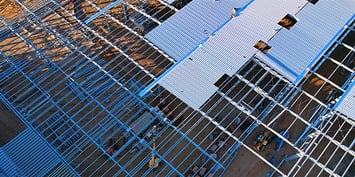Steel framing construction should be as mistake-free as possible. A well-framed structure can make the difference between a satisfied customer and one who is forced to deal with numerous structural and utility problems down the road. To avoid framing mistakes, you need to keep in mind the most common errors that can happen and ensure that you're using the right fastening tools for attaching other elements to the steel frame of your structure.
A powerful coil nailer such as the ET&F® (a BECK member) Panelfast® Model 510A pneumatic tool is one crucial example. It will make your framing work take shape much quicker. It's specially built for attaching plywood, oriented strand board (OSB), exterior gypsum sheathing, and fiber cement boards to steel frames in structures rapidly and firmly. To do this so effectively, the Model 510A uses Panelfast® AGS-100 pins. Along with this system for a correct framing job, here are several other key steel framing pointers you should keep in mind:
1. Improperly Installed Sheathing
A sheathing panel will have a span rating on its grade stamp that dictates how it should be installed. This always presumes that you've placed the panel in its correct orientation across at least three supports. Failing to do this could drastically weaken the integrity of your sheathing. Panels that are installed and fastened across only two supports are also much more likely to visibly sag.
The orientation of your sheathing panels is also important. For example, the plies and layers in plywood and OSB run along a cross lamination with their grain usually running along the long direction of one of these panels. The strength of these panels runs along this grain, and this means that you'll get ideal performance from them if they're fastened with their grain being perpendicular to your steel frames.
2. Overdoing Notching and Boring
While a certain number of holes and notches is necessary for attaching elements to steel framing members, having too many of them, or placing them incorrectly can lead to load-carrying weaknesses. You should follow clear guidelines for where notches are workable and how big, or frequent, they can be while preserving structural integrity.
3. Irregular and Overdriven Fastening
The quality of the fasteners you use in sheathing your framing job is crucial to their long-term performance, which is why we strongly recommend the Panelfast® AGS-100 pins for your steel framing. Specifically, they're ideal for applying sheathing materials like OSB, gypsum, or plywood robustly and firmly to your structure.
You should make sure to fasten regularly and with fasteners of the right size for the job. Their size should be enough for strong fastening but without over-tightening or not tightening sheathing firmly enough to the structure you're working on. Finally, fasteners should be evenly spaced for the sake of both aesthetics and structural integrity in both sheathing and frames.
4. Broken Load Paths
Much like wood frame structures, framed steel structures apply their loads from the roof downwards toward their foundation. As they do this, your frame should be designed so that weight of the load is transferred along the load-bearing paths that have been designed for that purpose. If you've built your frame so that the load path deviates into non-load-bearing parts of the structure, it can cause cracks and eventually, collapse.
5. Studs Gapped Along Floor and Ceiling Joints
If steel frames aren't cut evenly or according to their specific necessary lengths, they can come up short for placement. This can cause you to install them with a gap along their top or bottom tracks. Obviously enough, the gaps this creates will reduce load-bearing capacity in a framing member and the structure as a whole.
To avoid this potentially serious problem, measure all framing members and their corresponding floor-to-ceiling heights carefully before cutting and placing. Use good leveling tools and carefully check all studs for snug placement after having installed a section of framing. Fastening sheathing to gapped studs can also later cause the sheathing itself to sag as the studs fall out of alignment.
Using Powerful Tools for Your Framing
Many of the errors described can be easily avoided by using the right tools. For fastening, the ET&F® Panelfast® Model 510A pneumatic tool will help ensure that fasteners are applied to metal evenly. For applying panels to steel frames, Panelfast® pins ensure strength and longevity. Their Aericote® 1000 coating offers 1000 hours of salt spray corrosion protection while their ballistic point and knurled shanks deliver superb holding strength.
.svg.png)


